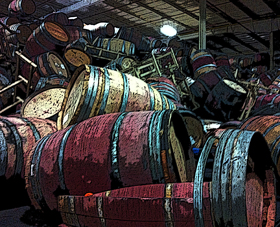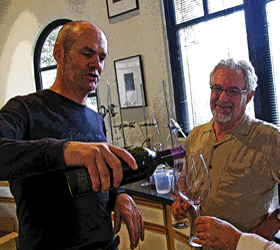Le Chanceux’s Tale of Inspiration, Courage & a Little Luck.
Sue McNerney was hoping to turn her passion for wine into a profitable business when the Napa earthquake struck on the morning of August 24th. “I was standing in the kitchen when I saw the pictures on my I-pad and I walked over to the door and I said ‘Oh my God. It’s gone. It’s gone!’ ”
In 1999 Sue and her husband Bob bought property in the Coombsville region of Napa Valley with the dream of producing estate grown Cabernet Sauvignon. They converted a one-acre horse pasture on their property into a vineyard and named it Belles Filles in honor of their three daughters.
Read MoreThe Topsy-Turvy Vineyards Of Babcock Winery.
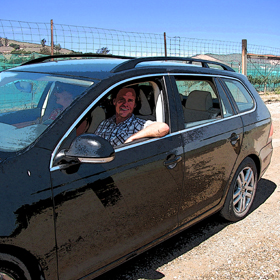
Bryan Babcock & WineSnark tour Babcock Vineyards in the Sta. Rita Hills appellation of the Central Coast.
From the back seat of Bryan Babcock’s Volkswagen I noticed something unusual about his vineyards. The grapes were experiencing an unusually early onset of veraison (when grapes soften and change color) but it wasn’t the patch-quilt appearance of the clusters that caught my attention. Babcock’s Pinot Noir vines appeared to be growing upside-down.
Babcock, a born innovator, explained, “I’ve worked out a system that allows the vines to grow more naturally. I’ve taken the starting point of my growing higher off the ground so that my shoots can grow down naturally … as opposed to working against gravity.” The visual effect can be startling
Read MoreDon’t Be So Sensitive; Sensory Adaptation & Wine Tasting.
Chapter Two, Part Seven.
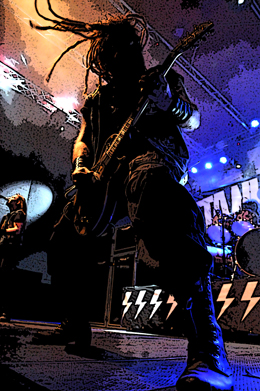 As a regular reader of WineSnark, you’ve learned the various ways your body perceives flavor so now you can relax, have a bite to eat and enjoy a glass of wine. Once you do however, you might as well throw all you’ve learned into the recycle bin because when you introduce new chemical compounds to your body the equation changes. By the way, my wife just loves it when she cooks all day and I tell her she’s made a delicious “chemical compound”.
As a regular reader of WineSnark, you’ve learned the various ways your body perceives flavor so now you can relax, have a bite to eat and enjoy a glass of wine. Once you do however, you might as well throw all you’ve learned into the recycle bin because when you introduce new chemical compounds to your body the equation changes. By the way, my wife just loves it when she cooks all day and I tell her she’s made a delicious “chemical compound”.
Food is just one of the many things that can affect your sensory perceptions, most of which you can control about as well as a bad comb-over on a windy day.
Read MoreThe (Rutherford) Dust Settles After The Napa Earthquake.
When natural disaster strikes we find ourselves ogling the harsh images on TV. Whether it’s the collapsed façade of a stately building in downtown Napa or the half-submerged skeleton of a landmark rollercoaster at the Jersey shore, these images become the icons of our tenuous hold on life. They remind us of what is truly important – the people we share our lives with.
A week has passed since the earthquake rumbled through Napa and as the dust settles we’re getting a better picture of its effect on the people and wineries of the valley.
I took a quick poll of some winemaker friends and discovered that many fared better than originally thought. Aaron Pott, Food & Wine Magazine’s “2012 Winemaker of the Year” voiced a popular sentiment heard around the valley when he stated, “We are shaken, not stirred”.
Pott – whose current winemaking duties include Pott Wine, Bello Family, Blackbird, Fisher, Jericho Canyon, Perliss, V22, Quixote, Seven Stones and St. Helena Estate – went on to report, “All Pott’s and Pott Wine is well! Our hearts go out to many that didn’t share our luck.” He then added, “We are busy preparing for harvest.”
This was the first earthquake for New Jersey native Bob Van Dyk of Van Dyk Family Wines.
Read MoreNapa Earthquake Delivers Bruising Punch.
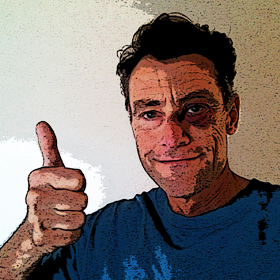 Lee Nordlund is sporting a colorful new bruise on his left eye courtesy of the 6.0 earthquake that rumbled through Napa early Sunday morning.
Lee Nordlund is sporting a colorful new bruise on his left eye courtesy of the 6.0 earthquake that rumbled through Napa early Sunday morning.
“In the dark of the wee hours our house suddenly pitched to and fro.” said Lee. “I leapt from bed to get Bridget out; I went north, the bed post went south, and I ended up with a shiner. The bed post seems to be fine.”
Lee is the driving force behind Punch Vineyards, a winery with two diametrically opposed goals; 1. Produce outstanding Napa Valley Cabernet Sauvignon. 2. Produce affordable Napa Valley Cabernet Sauvignon. He has succeeded at both.
Read MoreVisual Wine Inspection; Looking For Clarity, Color & Intensity.
Chapter Three, Part Five.
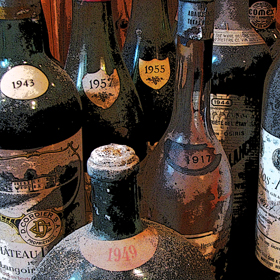 When analyzing wine a vigilant visual inspection will give you some clues as to the condition, age and style of the wine. Visual indicators may also offer you the first tip-off that the wine is flawed. For example, bad wine is often cloudy, off-color, or has a cute animal on the label.
When analyzing wine a vigilant visual inspection will give you some clues as to the condition, age and style of the wine. Visual indicators may also offer you the first tip-off that the wine is flawed. For example, bad wine is often cloudy, off-color, or has a cute animal on the label.
Begin your visual examination by checking the wine for clarity. Wine can become cloudy if bacterium gets inside the bottle, but before you turn that murky bottle into a grab bag gift at the office Christmas party you should know there is another cause for cloudiness that is not considered a flaw.
Read MoreThe Monthly Wine Writing Challenge; My Best Friend Wine.
“Writing is a lonely job, unless you’re a drinker, in which case you always have a friend within reach.” Emilio Estevez
 If you’re a wine aficionado, at one time or another you’ve probably said, “We can’t open the good wine when they come over.” Sure you love your friends but you rationalize your decision with sentiments like “they couldn’t possibly appreciate the wine we drink”.
If you’re a wine aficionado, at one time or another you’ve probably said, “We can’t open the good wine when they come over.” Sure you love your friends but you rationalize your decision with sentiments like “they couldn’t possibly appreciate the wine we drink”.
Obviously these wine locusts are three rungs beneath you on the evolutionary ladder and the only thing they have in common with you is opposable thumbs – which they’ll use to drink all your expensive wine.
Read MoreVisual Wine Inspection, Bubble Trouble & Cosmic Crystals.
Chapter Three, Part Four.
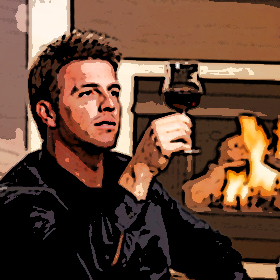 The first step of wine analysis is to take a good look at your wine. For this you will need an acceptable wine glass. You may be emotionally attached to that old Flintstones tumbler you’ve had since grade school, but it’s time to buy some nice stemware and part ways with Fred and Barney.
The first step of wine analysis is to take a good look at your wine. For this you will need an acceptable wine glass. You may be emotionally attached to that old Flintstones tumbler you’ve had since grade school, but it’s time to buy some nice stemware and part ways with Fred and Barney.
A good-sized, tulip-shaped glass with a thin rim will do nicely for most wines, providing it is clear. Avoid glasses that are tinted or painted. I’m sorry gentlemen but the logo of your favorite sports franchise may be appropriate glassware for the man-cave, but it’s unacceptable on your wine glasses. I know you’re reluctant to give up the team logo but if your wives were on the Pulitzer Prize committee, this stipulation would make Wine Snark a shoe-in for the award.
Read MoreIntro To The Obligatory Chapter On Wine Tasting Techniques.
Chapter Three, Part One.
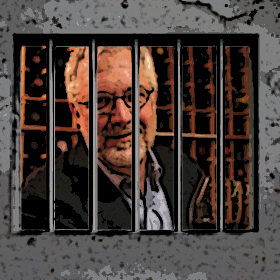 I know what you’re thinking. I said this wasn’t going to be like every other wine blog on the internet and I’m already writing about how to taste wine. Every magazine and book ever written about wine has a chapter about ‘Tasting Techniques’. I know it. You know it. Even your preschooler knows it because she read about it on her i-phone.
I know what you’re thinking. I said this wasn’t going to be like every other wine blog on the internet and I’m already writing about how to taste wine. Every magazine and book ever written about wine has a chapter about ‘Tasting Techniques’. I know it. You know it. Even your preschooler knows it because she read about it on her i-phone.
Before you skip to the next chapter or surf off in search of cute kitty videos you should know the ‘Tasting Techniques’ chapter is a pillar of wine journalism, an institution steeped in class and tradition, much like NASCAR and hOOters.
Read MoreBecome A Wine Critic Superhero.
Chapter Four, Part Two.
 Wine critic Robert M. Parker Jr. sets the standard when it comes to sniffing out and describing the aromas found in wine. He has a unique gift for making aromatic associations and it’s not unlikely that he possesses the greatest olfactory memory banks in the wine trade. This might explain why he has become the most respected wine critic on Earth (and possibly on Krypton). What I’m trying to say is Robert Parker has memories like Wonder Woman has mammaries.
Wine critic Robert M. Parker Jr. sets the standard when it comes to sniffing out and describing the aromas found in wine. He has a unique gift for making aromatic associations and it’s not unlikely that he possesses the greatest olfactory memory banks in the wine trade. This might explain why he has become the most respected wine critic on Earth (and possibly on Krypton). What I’m trying to say is Robert Parker has memories like Wonder Woman has mammaries.
The Los Angeles Times summed it up best when they called Parker, “the most powerful critic of any kind, anywhere.” Wow! That really does makes him like, a wine critic super hero.
Faster than a speeding simile! More powerful than a loco-metaphor! Able to leap tall bibliographies that are single bound!
Read More

